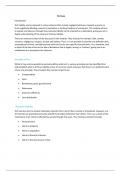Lecture notes
Tort Law-COMPLETE MODULE(LLB Exam plans, 1st Class)
- Module
- Tort Law
- Institution
- University Of Oxford
Unlock a complete and detailed guide to UK Tort Law expertly crafted notes. These comprehensive materials cover all key areas of Tort Law, providing a clear and structured approach for understanding complex legal principles. Ideal for students, professionals, and anyone looking to gain a deep...
[Show more]



